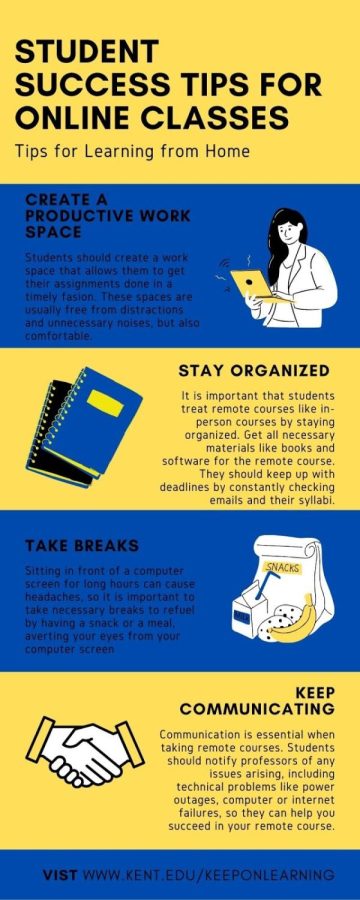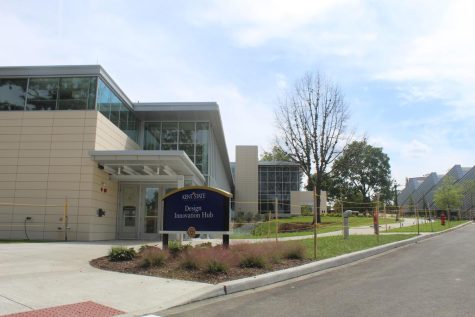Tips for students to be successful in remote courses
August 14, 2020
Coronavirus cases in the U.S. are rising, schools are reopening and college students are facing a new reality: remote classes. Without proper guidance in navigating remote classes, however, students’ academic performance could suffer.
Remote learning is a form of instruction delivered through an online platform—typically through learning management systems and video conferencing. Today, it is possible for students to take courses in almost any subject remotely, but since the pandemic hit, many students will be forced to take remote classes in the fall. For Kent State students, those classes resume Aug. 27.
Associate professor of educational technology Elena Novak said there are a few strategies to be successful in remote classes which can sometimes pose a difficulty for some students. She suggested students treat remote courses as they would “real” or in-person courses, communicate regularly with professors, stay organized and be aware of technical challenges.
“It is easy to fall behind in remote courses because they seem easier or more flexible,” she said in an email. “Block out time in your calendar to work on each of your remote courses.”
A study from niche.com revealed that 15 percent of college students find online instruction as effective as face-to-face instruction, 86 percent of those students had their classes changed to remote instruction and 74 percent have adequate access to the technology needed for remote classes, which suggests that more students nationwide will be taking remote classes, more are finding remote instruction ineffective and some are going without the devices needed for success in these classes. However, there are many online resources available for student success.
Students who have remote classes can visit Keep on Learning, an online resource that provides students with detailed information for navigating Blackboard Learn, communicating with professors, turning in assignments and academic testing. It also provides technology support, tips for success and answers to frequently asked questions.
Jennifer Marcinkiewicz, a professor of biological sciences and the director of the center for teaching and learning, said coupled with visiting the Keep on Learning resource, students should create a productive workspace, understand the expectations of their professors and ask questions.
“Understanding what it is that your faculty is asking for you to do and how they want you to do it is very proactive,” Marcinkiewicz said. “Reading through the syllabus and directions, asking questions and feeling empowered to ask your faculty members to clarify doing those sorts of things.”
With taking remote courses, many homes may have to transform to accommodate a practical and operational work environment that promotes productivity. This may include sitting in front of a computer for hours, so students should apply the 20-20-20 rule, a 20 second break from looking at a computer screen every 20 minutes to prevent headaches, eye strain or blurred vision, according to an article from Medical News Today.
Marcinkiewicz also stressed how setting goals and creating a daily structure can contribute to students’ success in online classes, reducing stress and burnout that may come with these classes.
“I think for students having a good healthy balance, taking breaks at certain times, so creating a structure that allows you to look at what you need to accomplish, look at the time available and then try to plan proactively how you’re going to space that out is just really doubly important,” Marcinkiewicz said.
With technology and the virtual environment, however, students should plan for internet connection disruptions, power outages and even technology malfunctions or breakdowns. Marcinkiewicz said during this time, it is important for students to communicate with their professors.
“There’s a lot more beyond our control,” she said. “So, trying to have a conversation with others in our environment that we can about how we’re going to manage to be really useful.”
Novak also supports this sentiment. She said students should be aware that professors may not know of their individual challenges, so it is vital that students communicate more often with their professors.
“Timely communication plays a very important role in your course success,” Novak said in an email. “It’s a student’s responsibility to notify the instructor of technical and seek technology support through university services.”
Physics professor Jim Gleeson emphasized that with remote classes comes additional responsibilities and accountability. He said students should ensure they are well-informed of their professor’s expectations, follow directions and communicate their needs immediately.
“Be on top of things a little bit more than you would in person,” Gleeson said. “Let people know at the very beginning what you will need.
But some students will not be able to be on top of things because they do not have access to a computer—a reality that the Instructional Resource Center at Kent State is attempting to address.
“There is a draft awaiting approval on an approach to help students who have technology needs,” said Julee Henry, the Instructional Resource Center Coordinator, in an email.
Novak suggested the following recommendations for professors in supporting students in a virtual environment:
· Rethink course structure and format
· Promote active learning and engagement
· Provide students with tips for success in remote courses
· Record virtual class meetings
· Make course materials available ahead of time
· Stay in touch with students
Marcinkiewicz said something equally important is that both students and professors should exercise patience and understanding with each other as everyone is learning how to adjust to this new reality—an occurrence that is constantly changing and requires constant learning for both parties.
“I would really encourage being patient with ourselves,” Marcinkiewicz said. “Extend grace and compassion, we’re all in together.”
Four student success tips in remote classes
1. Create a productive workspace: With the introduction of social media and new and emerging technological devices that pose a distraction for many, students will need to remove all distractions to create a productive workspace. A productive workspace is free from noises and unnecessary interruptions and promotes concentration and focus.
2. Stay organized: As professor Novak suggested, it is important to treat remote courses like that of a face-to-face course. When students do so, they get all the necessary materials such as books and software, keep up with assignment deadlines, stay on schedule and on top of all remote courses.
3. Take breaks: Because of the nature of remote courses, students will be on their computers for a longer period of time. The pandemic has changed how we do many things, but it is vital that we are mindful of how many new behaviors can affect our overall health, including looking at a computer screen for long hours, so it is vital that we factor time away from the screen in between remote classes to refuel by having a snack or even by getting some fresh air.
4. Keep communicating: Communication is extremely important when achieving success in remote courses. It is imperative of students to make the added effort to reach out and to stay in touch with their professors amid this new reality and change for both professors and students.


















